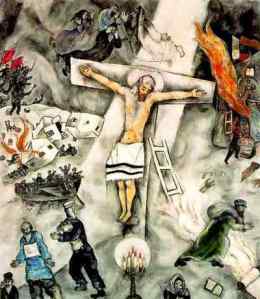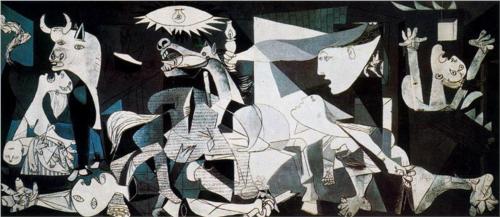Antisemitism – Jewish suffering – in the Jewish Jesus' name

A good Christian suggests that perhaps Auschwitz was a divine reminder of the suffering of Christ. Should he not ask instead whether his Master himself, had He been present at Auschwitz, could have resisted degradation and dehumanization? What are the sufferings of the Cross compared to those of a mother whose child is slaughtered to the sound of laughter or the strains of a Viennese waltz? This question may sound sacrilegious to Christian ears. Yet we dare not shirk it, for we -- Christians as well as Jews -- must ask: at Auschwitz, did the grave win the victory after all, or, worse than the grave, did the devil himself win?
Emil Fackenheim, God’s Presence in History (New York University Press, 1972, p. 75)
Marc Chagall’s “White Crucifixion” challenges both Jews and Christians to ponder the implications of Jesus being a son of Israel.

If you are Christian, how do you think the following painting strikes a Jewish observer? If you are Jewish, how do you think it strikes a Christian observer?
Take a look – your own look – at the White Crucifixion by Chagall – together with family, with your community, with students ---
What do you see? Ask your own questions of the painting, such as what the color white might suggest. And the cross – how complicated, what a complex of associations – different for "the Christian" than "the Jew"? And what of these set terms that make all the individuals of a community – indeed of a vast tradition, civilization – into a type – one and the same? Can there be any accuracy, any sense in that? And if so, how about the inaccuracy, the distortion it assumes and effects?
[ Copyright for picture: please see here... ]
Here Chagall depicts Jews trying to flee a pogrom – attacks from the Red Army – anticipation of the Nazi onslaught. Jesus is represented not as the paradigm of his suffering in the Christian theological sense, but as the ultimate emblem – sign – of Jewish suffering. His loin cloth is a Jewish prayer shawl – the tallit – and his halo coincides with the light of the menorah at his feet. He is here appropriated as the Jew he was in his life and teachings – and in his death – as wanting to aid his people as a messianic savior – thus seen as a threatening opponent of the Roman occupation.
Or we might even see the figure on the cross as not Jesus, but the Jew of all times – whose suffering finds its strongest source in the very religious tradition that sees its derivation in a Christianized Jesus. It is Jewish suffering that has come to represent the suffering of all humankind. Jews have come to represent every difference, every otherness that is maligned – for which, for whom there is no room for inclusion. All this a close reading of this work by Chagall – perhaps indeed his Guernica – his ultimate work of witnessing and protest in the faces of human suffering – Guernica which was completed by Picasso just one year before the White Crucifixion.

For more discussion of this painting see:
Broken Continuities: "Night" and "White Crucifixion" by Karl A. Plank – at:
http://www.religion-online.org/showarticle.asp?title=1069
&
Marc Chagall's 'White Crucifixion': An Enduring Work of Political Art by Ariel Kravitz - at:
http://ejournals.library.vanderbilt.edu/vurj/viewarticle.php?id=142&layout=abstract

[ Copyright for picture: please see here... ]